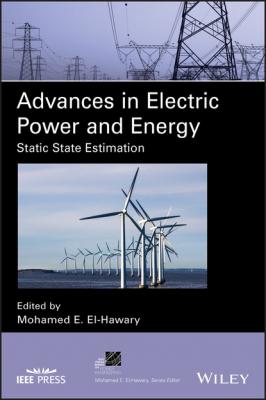Advances in Electric Power and Energy. Группа авторов
Читать онлайн.| Название | Advances in Electric Power and Energy |
|---|---|
| Автор произведения | Группа авторов |
| Жанр | Физика |
| Серия | |
| Издательство | Физика |
| Год выпуска | 0 |
| isbn | 9781119480440 |
Figure 2.4 Objective function for the QC estimator as a function of the error (one measurement).
2.5.3.1 QC General Formulation
The general formulation for QC estimator is
(2.34a)
subject to
(2.34b)
(2.34c)
(2.34d)
The objective function of problem (2.34) has a quadratic shape for each of those measurement error values that are within a tolerance T; otherwise, the objective function component has a constant value (see Figure 2.4). Note that a tolerance T must be selected in advance.
2.5.3.2 QC Mathematical Programming Formulation
QC mathematical programming formulation is
(2.35a)
subject to
(2.35b)
(2.35c)
If problem (2.34) is to be expressed as a standard mathematical programming problem, then a binary variable vector b must be added to the optimization variable set. The resulting formulation (2.35) is a mixed integer nonlinear problem.
Although problem (2.35) is a mixed integer nonlinear programming problem, the set of constraints (2.35d) can be relaxed:
leading to a relaxed mixed integer nonlinear programming problem. This relaxed problem can be tackled by any nonlinear programming solver (such as MINOS [11]). Numerical simulations show that the particular structure of problem (2.35) imposes that relaxed binary variables bi have a binary value at the optimum, i.e.
2.5.4 Quadratic‐Linear Criterion
QL technique is a state estimator that is similar to the previously considered QC method but involves linear terms rather than constant terms outside the tolerance region.
In this chapter, it is considered that the linear parts of the objective function of this estimator coincide with LAV objective function. Other works [23, 24] characterize these linear terms as tangents to the quadratic component so that the derivative of function J(x) does not have any discontinuities. Note that the formulation proposed in this chapter presents two derivative discontinuities at points at yi(x) = − T and yi(x) = T.
From the optimization perspective, the approach analyzed in this work has some benefits: (i) it can easily be formulated as a mathematical problem using a smaller number of binary variables and/or constraints than the quadratic‐tangent technique, (ii) the resulting problem structure allows binary variables to be relaxed without altering the optimal solution, and (iii) numerical simulations suggest that the time required for CPU is significantly smaller than that required by the quadratic‐tangent approach.
2.5.4.1 QL General Formulation
The QL general formulation is
(2.36a)
subject to
(2.36b)
(2.36c)
(2.36d)
Figure 2.5 depicts the objective function for QL estimator in the case of one single error. The violet and green curves correspond to a high and low weighting factor ωi, respectively. Note that the behavior of function J(x) for the QL estimator is the same as WLS if the measurement error yi(x) is within given bounds.
Figure 2.5 Objective function for the QL estimator as a function of the error (one measurement).
The objective function value of QL estimator for a given measurement has a quadratic shape (like WLS estimator) if the measurement error value is within a tolerance T; otherwise, this objective function component has an absolute value shape like LAV estimator (see Figure 2.5). Note that a tolerance T must be selected in advance.
2.5.4.2 QL Mathematical Programming Formulation
The QL mathematical programming formulation is
(2.37a)
subject to
(2.37c)
(2.37d)
